How Teletext and Ceefax are coming back from the dead
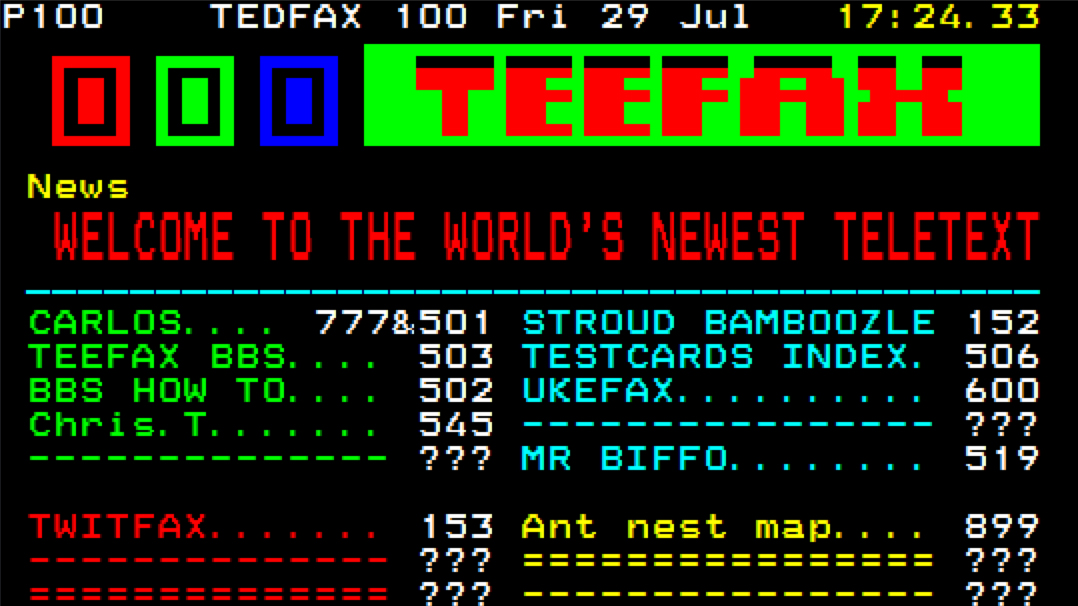
On October 24 2012, analogue TV transmitters were switched off for the final time, as digital switchover was finally complete.
You probably didn't notice at the time, as by then everyone was watching TV digitally. But not only did it mark the end of an era for TV broadcasting, it was also when the heart of a dear, trusted friend stopped beating: Ceefax.
Ceefax and teletext services are dead. The "text" button on your analogue TV remote control has been forever rendered useless. The spectrum that used to beam the likes of Backchat, Bamboozle and Digitiser are now used by our 4G devices.
But amazingly, that's not the end of the teletext story. A small band of geeks have managed to resurrect the old format, and have recently launched a brand new teletext service. Seriously - a new teletext service has launched in 2016.
Teefax is the latest accomplishment by the group, who have previously figured out how to extract old text pages from VHS recordings so they can be saved together, have figured out how to get around the lack of TV signal by using the internet.
The way it works is that plugged into an old analogue TV is a Raspberry Pi, complete with composite output. Teletext pages are downloaded from a central server and transmitted through the Composite signal into the TV.
This isn't an emulator - this isn't just throwing up seven colours of blocky text on a black background and pretending that it is teletext.
Sign up for breaking news, reviews, opinion, top tech deals, and more.
This is real - the text pages are encoded into the video signal and accessed by pressing the "text" button on the remote. The microprocessor in the TV responsible for decoding teletext is what is doing the work.
So as ever, pages can be accessed by dialling in page numbers on the remote - exactly the same way as the old days. You can install it yourself in minutes if you're comfortable with the command line and are happy following instructions.
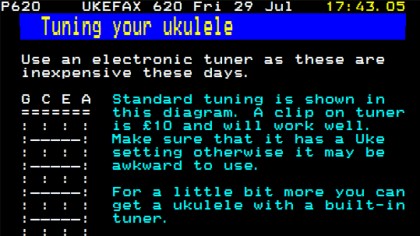
At the time of writing, the service has been live for a few weeks and is more like a proof of concept - with a number of developers taking control of a few pages for themselves to share text or their best teletext art.
There are even some pages that pull in data from the web and convert it to teletext format. Page 153 displays a stream of recent tweets, and page 503 even has what is presumably the world's least convenient messageboard system. On page 888, where subtitles would traditionally reside, is a rolling set of (terrible) jokes that make use of the fabled "reveal" button.
The ability to display real text pages has been possible for some time now - but the idea to hook it up to a central server so that it would transform into a fully fledged teletext broadcasting system is new. Forget Web 2.0 - "it would be like web zero", the man who had the idea - Carl Attrill - tells me.
He was inspired by the work of Peter Kwan, who used to work in visual effects and computer graphics - including on teletext systems for both ITV and the BBC.
Fringefax
Having previously written wxTED, a much-needed teletext editor for modern PCs, Peter built his own text service for the town of Stroud, for its Fringe festival. Using the Raspberry Pi, "Fringefax" was planned so that TVs around the town would display the schedule and other festival information.
"To keep it up to date the screens needed to synchronise pages from a central server", Peter says. "Then I had a brainwave in that I could use a standard package called Subversion that does all the housekeeping and is very easy to use."
Subversion is a software versioning system, which enables people to edit parts of a project remotely and then save their changes and synchronize with everyone else - with no one's work being overwritten by accident.
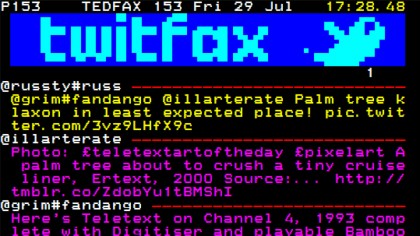
It's perfect for Teefax because it means individual pages can be modified and within two minutes of changes being uploaded (or "committed", in the jargon), the updates will be visible on all Raspberry Pis running Teefax.
The service currently has a number of contributors, including artist Dan Farrimond who has produced some truly magnificent graphics, despite the limitations inherent in teletext. In fact, his work has even won him a 'residency' on German network ARD's own teletext service.
Where does it go next?
The teletexters are currently hard at work planning the inaugural Teletext Festival at the National Centre for Computing History - so the same system is being revived again, this time as a permanent thing.
But where can it go next? Peter says that he sees the current setup as a "transitional" system. And he has big plans.
"The next iteration will be web based with instant transmission. As you edit a page anyone viewing that page will see your keystrokes as you type. In fact anyone can type on the same page and collaborate. It will be able to carry hundreds or thousands of services and these would include people's personal teletext services and the many services recovered from tape."
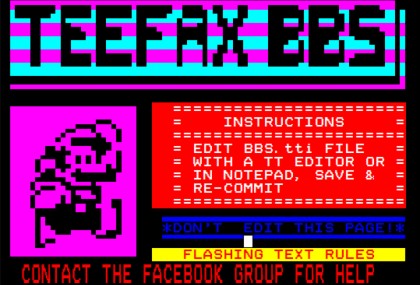
This latter part is particularly exciting. Though old teletext pages can now be recovered from old VHS tapes, no one has yet created a central repository and it has been up to individual 'Teletext Archaeologists' like Jason Robertson, to post the recovered pages on their blogs.
If Peter can build an archive using the same principles as Teefax (with a central server), teletext pages could be made accessible forever, in an exact recreation of their original format, browsed as they were originally intended rather than as screenshots.
He's dubbed this system Muttlee - standing for Multi User Tele Text Live Editing Environment.
And if you're wondering how he plans to squeeze potentially tens of thousands of pages on a system limited to just 999 pages? The answer is simple: Like going from Ceefax to Teletext, all you'll need to do is change to a different channel.
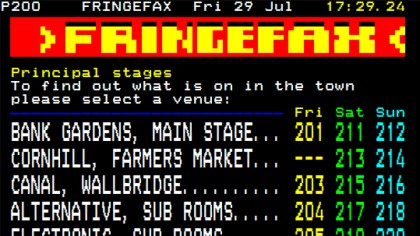
So it appears that the future of teletext, contrary to expectations, might actually be rather bright. Carl tells me how Teefax is already proving rewarding for the small but dedicated Teletext community - and how he likes that his two sons, aged 10 and 14, are able to experience the system just as we remember it.
"Others have spoken of rediscovering teletext as bumping into an old friend", Carl explains.
Perhaps best of all though is that after 40 years teletext doesn't have to be assigned to the dustbin of history.
Thanks to a smart-thinking group of enthusiasts a once mighty service, that was accessed by millions in its heyday will live on forever.